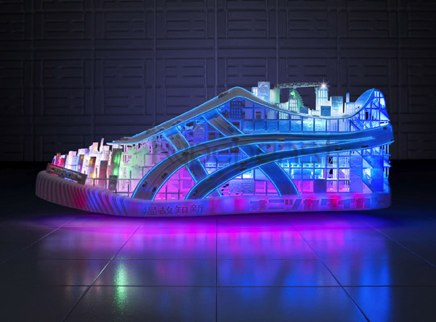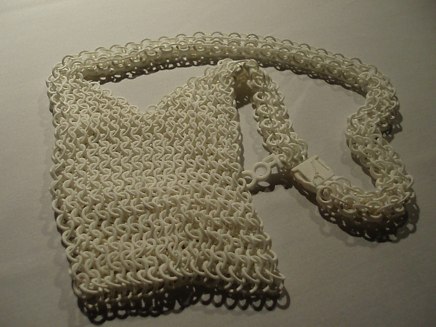
by Emily Kemper
The simple act of registering for May's GRAVITY FREE conference in Chicago was a thrill: "Register early," we were told,"and you'll get access to everything the conference offers PLUS e-books from the speakers!" GRAVITY FREE bills itself as a multidisciplinary design innovation conference that breaks the mold of traditional design conferences, and with a list of presenters that included Karim Rashid, Theo Jansen, Stefan Sagmeister, Massimo Vignelli, and Michelle Kaufman, it was easy to get excited. After all, GRAVITY FREE, with its capital letters and rock-star theme - "The Year of Dangerous Minds" - promised inspiration, and if it didn't deliver, you could ask for your money back.
I attended the conference on May 12 armed with a press pass from Archinect.com and sponsorship from the USC Stevens Institute for Innovation, both a source of inspiration in my own life. I entered the halls of the Museum of Science and Industry in Chicago as the perennial observer; eyes open, mouth shut, with few expectations but great anticipation. GRAVITY FREE promised a shared experience; everyone would attend the same presentations, participate in the same Q&A sessions, and have the same chances for round-table discussions at the end of the day. I emerged three days later with a head full of ideas, a great sense of potential - and a blog full of anecdotes and observations. More than anything else, however, I gained from GRAVITY FREE a greater understanding of how innovation is propelling design into the future by turning towards technology, as well as returning to basics.
Take Arturo Vittori, for example. He's shooting for the moon, literally. MoonBaseTwo,
designed with his partner Andreas Vogler through their company Architecture and Vision, is a habitat meant for lunar living that looks suspiciously like an igloo. In fact, both structures are based upon the idea that a spherically-shaped outer shell provides the maximum exposure to the sun, and therefore provides the most warmth. Bob Gruen, a legendary rock n' roll photographer, might be described in the context of the conference as a "designer of visual culture" since his medium of film so expressively described the historical context in which rock culture emerged. Ryan Genz and Francesca Rosella are taking the most cutting edge technology and placing it in the most obvious and most tactile place - our clothing.
Deborah Adler simplified a prescription labeling system for her master's thesis in
graphic design - and in doing so, she revolutionized the entire industry.
The round-table sessions at the end of each day provided a unique opportunity to
interact with the speakers we had just seen. Unfortunately, I have not yet developed the ability to appear in 13 places at once, but for my first session, I was lucky enough to find space a Janne Kyttänen's table. Even designers familiar with advanced techniques in 3D printing would be amazed by the objects that Kyttänen and his firm, Freedom of Creation, produces. These objects include a 3D model of a "shoe city" inspired by Tokyo, and a satchel made of chain mail (below), both products of a still-tedious process of 3D printing that "prints" special powder with a laser at the rate of about a 1/2 inch per hour.
Freedom of Creation: "Electric Light Shoe" for Onitsuka Tiger
image courtesy of hypebeast.com
Freedom of Creation: "V-bag" shoulder bag
Most of us at Kyttänen's table were interested in the way he goes about
designing these objects, which, he told us, account for 60 percent of his firm's
profit. Remarkably, he explained that he doesn't do hand sketching anymore
either; the computer is his medium, and he uses it with the ease of a pencil and
sketchpad. Intrigued about his manufacturing partners, I asked if he would ever
be interested in maintaining his own manufacturing facility, a practice that
Michelle Kaufman had embraced for her pre-fab housing and described the day
before. "I highly doubt I would ever get into that business," Kyttänen said. "If
you have a company doing your productions, they can make a mistake, and if you
hire some guy to do production in-house at your company, he can make a mistake
... so it's just a matter of contracts, how you're going to put it on paper. How
do you define the quality of a product ... I think the point is they are doing
our manufacturing much better than I would.....and to be honest, what we're
doing is really on the borderline. The profits are still very very small, you
have a lot of products, very expensive, so it's quite a risky business." He said
that rather than get into the manufacturing business, "I would just want to go
into the creation of big libraries of 3D models" so that people with their own
3D models could print out whatever they wanted. This approach to planning for
the future of his design practice shows that Kyttänen is adept at using
technology to innovate.
While Janne Kyttänen uses high-tech 3D printer powder to produce his fantastic
creations, Bryan Berg 's building blocks are famous for their simplicity: he uses playing
cards, and lots of them. He is most famous for building large card houses and
holds the Guinness World Record for World's Largest House of Cards . However, as I found out at Berg's own round-table session the next day, his interests lie in buildings much more practical than card houses. He is an architect by training, having received his Master's Degree from the Harvard Graduate School of Design, and currently he works as a
consultant on projects in Santa Fe, New Mexico. His work with playing cards has
led him to develop a structurally rational approach to his architectural designs. "I'm really big into things looking the way they are built," he said."That's probably what I like about cards, is that it's very real in terms of what you see is really what's happening ... there's not a way to clad card buildings."
Bryan Berg at work
image courtesy of wikimedia.org
Berg discovered just how rigid playing cards can be when he took them into a
structural testing lab. After setting up a load distribution cone with plywood
and placing the cards in a waffle configuration, his load tests revealed that
this construction could withstand over 600 pounds of pressure .
With this in mind, "you could create larger dwellings very easily," says Berg.
In fact, he directed the framing of two buildings in a day using a scaled
translation of this waffle construction in modules, and he offered that "you
could build an entire town of houses out of this method in weeks." You could
even build vertically, he proposed: "With a large amount of plywood, you could
actually build buildings incredibly tall ... I'd have to do some thinking about
what the direct translation would be, but I think it would be very doable." With
these concepts, Berg proves that innovation doesn't have to be high-tech to be
effective.
Looking back on GRAVITY FREE , I'm impressed with the breadth of
designers who presented at the conference. All of the attendees were truly
exposed to a broad spectrum of ideas, and, as promised, the access to the
speakers was unparalleled. But I wonder if the myriad of designers at the
conference realize the significance of the ideas we witnessed there; I wonder if
these "dangerous minds", who are using simple ideas to advance new technology,
grasp that their innovations are laying the groundwork for a new generation of
designers to propel the world into the design future that we've always imagined.
GRAVITY FREE may not set out to raise these questions, but for
the time being, it's a great place to find people to have a conversation about
them.
3 Comments
emK- great synopsis. glad you found your 'voice'!
So will you be presenting at next year's gravity free?
treekiller, you are very kind....but I think it will be a few years and a lot of hard work before I get my own invitation to speak at Gravity Free. Still, I'd like to see more participation by architects and other designers at this conference. I'd like to see it get bigger and the "meeting and greeting" needs to be more integrated. I have all sorts of thoughts on the structure of the event, if they'd like to consult me, I'd be fine with that :o)
THIS NEEDS TO HAVE MORE ARCHITECTURAL INFLUENCE, THE EXCHANGE WOULD BE HEATHY FOR ALL THE DESIGN PROFESSIONS. EMILY YOU ARE RIGHT IT CAN ONLY GET BETTER, SEEMS TO BE LACKING A LITTLE IN CONTENT AND DISCAPLINE DIVERSIFICATION.
Block this user
Are you sure you want to block this user and hide all related comments throughout the site?
Archinect
This is your first comment on Archinect. Your comment will be visible once approved.